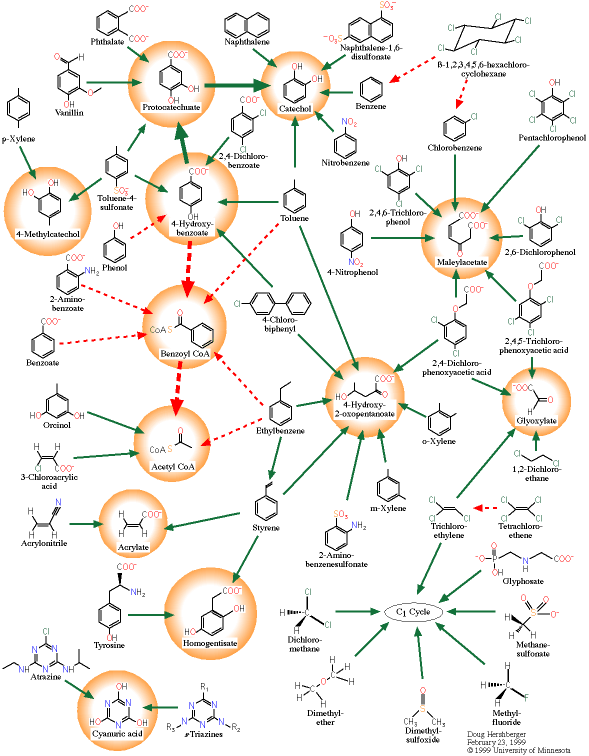EAWAG-BBD Metapathway Map
[BBD Main Menu]
The EAWAG-BBD Metapathway is a graphical representation of many of the pathways in the EAWAG-BBD and how they connect through common intermediates to form "trunk pathways."
The trunk pathway concept springs from the observation that many compounds can be classified into groups which share similar mechanisms of biodegradation.
In diagrams of the biodegradation pathways for all of the compounds of a particular group, the pathways start like the branches of a tree then converge into a single, common trunk.
All of the members of that groups are metabolized to the same intermediates, which are then further degraded.
We refer to these intermediates, common to all members of the group, as "common intermediates."
One example is the s-Triazine
Metapathway in which all of the compounds converge to the common intermediate cyanuric
acid. Trunk pathways are the biodegradation pathways for common
intermediates.
Trunk pathways usually feed directly or indirectly into common intermediary metabolism.
For example maleylacetate feeds into intermediary amino acid metabolism.
Other trunk pathways, while they can feed into common intermediary metabolism, can also be part of more specialized microbial metabolism.
Examples are the many pathways which produce C1 compounds (common in intermediary metabolism) but which also form part of the C1 cycle of the methanogens and methylotrophs.
Trunk pathways can be considered to be the funnels through which many unusual compounds pass into basic microbial metabolism.
Below, several pathways are symbolized by arrows from the starting compound to a common intermediate that they share with other pathways in the EAWAG-BBD.
Common intermediates are circled and link to KEGG intermediary metabolism maps.
Uncircled compounds start EAWAG-BBD pathways. They link to EAWAG-BBD pathway maps.
The intermediate compounds shown below are not the only intermediates for a given pathway, but rather they are the funneling points shared by more than one EAWAG-BBD pathway.
In many cases the starting compounds can also be degraded through other intermediates, not shown.
This metapathway map contains almost all of the pathways in the EAWAG-BBD as of November 19, 1997.
Pathways which have been added since then are not shown here.
A current List of all EAWAG-BBD Pathways is available.
Pathways specifically not included on this map are those for Dibenzothiophene Degradation and Dibenzothiophene Desulfurization.
|

|
Degraded from the indicated starting compound to an intermediate compound, aerobically |
|

|
Degraded from the indicated intermediate compound to another intermediate compound, aerobically |
|

|
Degraded from the indicated starting compound to an intermediate compound, anaerobically |
|

|
Degraded from the indicated intermediate compound to another intermediate compound, anaerobically |
Click on a circled compound to go to a pathway map in the EAWAG-BBD or KEGG which continues metabolism from that common intermediate.
Click on an uncircled compound to go to the EAWAG-BBD text pathway map which shows the biodegradation of that compound.

Click on a circled compound to go to a pathway map in the EAWAG-BBD or KEGG which continues metabolism from that common intermediate.
Click on an uncircled compound to go to the EAWAG-BBD text pathway map which shows the biodegradation of that compound.
[BBD Main Menu]
Page Author(s): Doug Hershberger and Lynda Ellis
Contact Us
© 2024, EAWAG. All rights reserved.
http://eawag-bbd.ethz.ch/meta/meta_map.html
![]()
![]()
![]()
![]()
